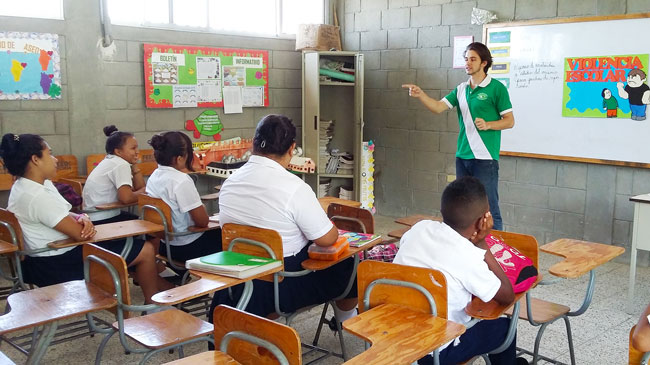I woke up earlier than usual that morning because of the Honduran woodcreepers that perched right outside my bedroom window. Minutes later, still in bed, I heard several faint bangs and pops.
I thought, “Who in the world is lighting off fireworks at six in the morning?” I became fully alert and awake.Those weren’t fireworks.
I got dressed and prepared my things for work. After locking our house’s barbed-wire topped gate, I walked across the street to the bus stop. There I froze, watching a procession of police and military trucks pass in front of me as they left the neighborhood. Eight men with shotguns and semi-automatic rifles sat in the bed of each truck.
I checked my surroundings, hailed a cab and went to work like any other day.
Honduras is home to a welcoming people, ancient Mayan ruins and the largest coral reef in the Atlantic Ocean, but tourists often avoid going there.
Honduras has the highest homicide rate in the world. In 2014, 75 of every 100,000 Hondurans were murdered. Over the past five years, Honduras’ industrial hub, San Pedro Sula, has teetered between the highest and second-highest murder rate of cities in the world, peaking at 187 homicides per 100,000 residents in 2013.
The Honduran people are not inherently more violent than their Guatemalan, Salvadoran and Nicaraguan neighbors. Honduras has a gang problem.
Like the popping I heard that morning before work, incidences of violence happen daily in Honduras’ largest cities due to gangs fighting other gangs for territory or fending off armed government forces.
For this reason, many Honduran families or heads of the family make the grueling trek through Guatemala and Mexico to the United States, the land of opportunity where, if you work hard, you can succeed in anything.
Before Donald Trump builds “a giant wall” along the United States-Mexico border, it is our responsibility to understand how the United States has played a hand in causing the gang violence in Honduras and to support immigrants who are trying to provide safety for their families.
From August 2015 to July 2016, I volunteered with an organization of the Honduran Mennonite church called Proyecto Paz y Justicia in La Ceiba, Honduras. On a near daily basis, I interacted with people and communities that were affiliated with or directly affected by gangs. Over time, they made clear some of the underlying causes of the prevalent Honduran gangs.
In the 1980s, the Reagan administration cut off economic aid to a struggling Nicaragua, because of the Nicaraguan government’s Marxist influence and socialist ideology. The Contra army that Reagan covertly supported was based in Honduras. Over the course of the nine-year war that followed, thousands of Hondurans and Nicaraguans fled to El Salvador and Guatemala, where they were having civil wars of their own.
This group of Central American refugees had nowhere else to flee but north. Many of them settled in Los Angeles and quickly formed communities to protect their fellow Salvadorans, Hondurans, Nicaraguans and Guatemalans. After clashing with gangs that were already present in Los Angeles, some of these communities formed into gangs, including one of the largest gangs in the Americas, Mara Salvatrucha, or MS13.
Barrio 18, a Mexican gang that was already in Los Angeles, recruited other Central American immigrants and formed a brutal rivalry with MS13, fighting for territory all across east Los Angeles. MS13 was the same gang that controlled the neighborhood in front of my house in Honduras.
In an attempt to subdue the violence in Los Angeles, the Clinton administration passed a law that allowed the deportation of foreign-born residents who had spent a year or more in a United States prison.
Between 2000 and 2004, an estimated 20,000 Central American immigrants were deported to their respective countries, including many gang members and leaders.
There, the gangs grew and transformed from street gangs fighting for territory to criminal organizations specializing in international drug-trafficking.
The immigrants coming from Mexico and the rest of Central America are not rapists and criminals. They are unaccompanied minors, worried fathers and determined mothers trying to escape the hold of violent gangs that our government sent down there.
Nearly every time I met someone new in Honduras, they would mention to me their father, uncle or brother in the U.S. that sends them money for school supplies, cell phones or even groceries. Ask any Honduran on the street and they will know someone who works in the U.S. or tried to get there and didn’t make it.
Before Trump begins to build that wall, let us keep in mind what drives our neighbors from the south to our border and how we can support them.


